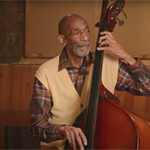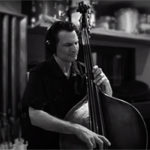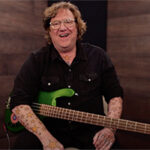Canadian bass virtuoso describes the making of his killer new recording, his one-man show and what lies ahead
Exclusive interview with FBPO’s Jon Liebman
October 10, 2016
A native of Ontario, Canada, Jason Raso is a master of the 4-, 5- and 6-string electric bass. A talented composer and bandleader, Jason has released eight albums as a leader to great critical acclaim. His latest compilation, Man of 40 Faces, features fellow Canadian bassist Alain Caron, trombonist Wycliffe Gordon and vibraphonist Francesco Pinetti.
FBPO: Tell me about your musical upbringing. Do you come from a musical family?
Raso: Well, my older brother is a guitar player and is still playing and touring around, so he was kind of the first in our family to play. My parents weren’t musical, [but] they loved music, so there was always music playing.
FBPO: Do you remember what kind of music was playing?
Raso: It’s funny. It was a pretty funny mix of stuff because my dad came to Canada from Italy when he was 18, so there was some Italian music that he was into, but was also really into what was happening here. It was all new to him. He came from a really small town and one of the first concerts he saw was James Brown at Maple Leaf Gardens when he came over. I still have the album hanging on the wall that he bought at that show. A lot of Sam Cooke, Otis Redding, Joe Tex. He had all these albums, so he would listen to all that stuff.
And then my mom liked pop stuff, so she liked Elton John and Queen, you know, and in the ‘80s, she loved Prince and Bruce Springsteen, so it was very much a mix of it.
My older brother was into rock music. He loved Van Halen and all the Joe Satriani stuff and Steve Vai. So I started playing bass because he was already playing guitar and I thought it would be fun to play with him, so it was like, “You know what? I’m gonna try it.”
The first couple years, I didn’t really know what a bass was, right? I knew Billy Sheehan and all the over-the-top tapping stuff. Later, I came to understand how solid Billy is as a bass player. I think he’s underrated in terms of his actual bass playing. I think people concentrated on the tapping stuff, but he’s such a good bass player.
Toronto was not too far away [from where I grew up], so we would go to concerts, mostly rock concerts. I remember seeing Mr. Big in the early ‘90s, going to see Ozzy and Metallica and a bunch of shows. When I started getting into Bass Player magazine is when I started to read about all these other players, and then, before you know it, you’ve completely fallen down the rabbit hole and you’re buying all kinds of stuff [Laughs].
I remember going to a Metallica concert in Toronto years ago and I had just read about Jaco and I thought, “Well, I’m gonna go upstairs to this jazz section in this big music store and see if I can find this Jaco guy. And I remember walking in and asking the clerk, you know, “Hey, do you have any Jaco Pastorius?” And I’ve got the long hair and the Metallica t-shirt on and he just looked at me like, “What?!” [Laughs] “What are you doing up here?” And I got into the jazz stuff and before you know it, you’re all over that stuff.
FBPO: Who were some of your other musical inspirations?
Raso: First it was Billy Sheehan and Stu Hamm. The first concert I ever went to was Joe Satriani at Massey Hall in Toronto and Stu Hamm was on bass. That was a big thing because the bass was really prominent in a live setting, and there were no vocals, so it was like, “That’s cool.” That was like the first step toward me writing instrumental music, so he was a big guy. Randy Coven was a big guy back then that I liked.
FBPO: I remember him. He died.
Raso: Yeah, he died, which is sad, but I really liked his playing. He had a couple albums, Sammy Says Ouch, there was some funk stuff on there and some jazzy stuff and obviously rock. And then it was Jaco and Marcus Miller and Stanley Clarke.
FBPO: The usual suspects.
Raso: Yeah. But then there’s a guy Jonathan Marin from Groove Collective, a band that I really got into. I loved Tony Franklin and his playing.
FBPO: Fretless Tony!
Raso: Yeah. I loved Doug Wimbish and Muzz SKillings, who were in Living Colour. Les Claypool, obviously, Michael Manring. And then I got into Alain Caron and that was a big deal for me because, one, he was Canadian and he was leading his own bands. And I was like, “You can do that?” [Laughs]
FBPO: UZEB!
Raso: Right! UZEB. So when I discovered him, that was a big deal because I thought, “I can do that. That’s what I want to do. I want to lead my own band, I wanna write.” I remember the first time hearing Marcus Miller’s Tales album, I couldn’t believe it! I was like, “You can play the melody on bass? You’re allowed to do that?! And then you trace everything back, right? Marcus played with Miles, so you’re like, “Well what’s he all about?” And before you know it, you find all this stuff. Charles Mingus. I have a real affinity for bass band leaders: Stanley Clarke, Marcus Miller, what Jaco was doing, Mingus, Alain Caron. I had a real affinity for those players.
FBPO: Tell me about your one-man show.
Raso: I do a lot of solo bass arrangements of either tunes I write or I’m doing some Beatles stuff. It’s fun. It’s a way for me to go do workshops too, so usually I tie them into a clinic.
FBPO: Do you have stuff sequenced on a computer?
Raso: No, I either have to loop it live or they’re complete solo pieces. It was just kind of as a challenge and sometimes, you know, you’re between band projects. A lot of times when I’m writing, I write the pieces that way then you kind of divvy up the parts. “Well, okay, this would really be a keyboard or this would really be a drum part,” but you kind of end up with these little solo pieces. That’s really how the last album came about, The Man Of 40 Faces album was part of that process.
FBPO: There is a lot of unaccompanied bass on that record, particularly in the suite. What were trying to say with this record compared to The Red Arrow and Slingshot?
Raso: That’s really what this was about. It’s funny because a lot of the pieces on The Red Arrow and on Slingshot were written that way. They were written as little unaccompanied bass parts and I would overdub a thing to get the song demo done and then I would send it out to the guys in the band and then, before you know it, it’s a band. But on this one, [I thought] “You know what? I’d like to record the album this way and then figure out how to play it live,” so some of it I have to loop live. There are no pre-recorded tracks. I don’t know why I had it in my head, but that’s the way it is. But the suite especially was something that I really wanted to get out and I was really happy with the way that turned out. Yeah, I wanted it to be just bass and then the duets on the album, with Wycliffe Gordon. Then I reached out to Alain Caron and I thought there’s no way he’s going to say yes to this, but he did! And then I had that moment of, “Oh no, he said yes!” [Laughs]
FBPO: Tell me about your equipment.
Raso: I was with Spector basses for a long time. A friend of mine runs a company here in Guelph, actually, called Ultimate Basses and he’s a Canadian dealer for Fodera, MTD, Spector. I’ve always wanted a Fodera; they’re just such beautiful basses. It’s kind of hard when you’re local. There aren’t a lot of opportunities to do stuff, so Dave said, “Why don’t we talk to the guys at Fodera about coming on as an artist?” I was kind of feeling reluctant to do it and he said, “What’s the worst thing that could happen?” So we reached out and they were like, “Yeah, let’s talk about it.” So, for the last year or so, I’ve been with Fodera and it’s just awesome. I couldn’t be happier. I’m playing an “Emperor 5” and I have a high C string on it. My main 4 is one of the “Monarch” standards.
FBPO: Why did you choose the high C instead of the low B? It’s not unheard of, but it’s not nearly as common.
Raso: It’s funny. When I moved away from Spector, I was playing an F Bass, the F6, for a while. A lot of Man of 40 Faces was recorded on that bass. I realized at the end of the process that I didn’t really use the low B at all. I was playing a lot of chords and I was playing a lot of solo lines. Even the bass lines never really drifted on to the B string, and I thought, “That’s kind of weird. I’m gonna try a 5 with a high C.” I ran the solo set and I think I maybe missed [having] the B, once. It was like, “Oh yeah, I guess I was using the low B there. It was like a better fit for me; it was a little easier to get around and I love it for the chords and for playing, especially when you loop, ‘cause I’ll do a low line, maybe loop some chords, and it’s nice to have the high C for the melodies to sit. But in a band setting, I still like playing a 4. The 5 has really become for my solo sets and I still like just playing a 4, if we’re doing a jazz gig or just a regular band gig, I like playing a 4-string.
FBPO: How about amps?
Raso: I’ve been using the Gallien-Krueger MB Fusion head. It’s nice. And I’ve been using the Schroeder cab. York makes them. They’re in California.
FBPO: And strings?
Raso: D’Addario. One of the reasons I play D’Addario, I worked in music stores years ago, teaching and working in the store, and that’s what everybody had. That was just the brand that you knew you could get anywhere. So I started playing those years ago and I basically stuck with them. So I’ve been playing D’Addario for as long as I can remember.
FBPO: What else do you like about D’Addario strings?
Raso: The new Balanced Tension sets are really nice. And the new NYXL series I really like. I find them really even. With D’Addario, I know what I’m going to get. I like the tone and they always feel the same to me.
FBPO: So what’s next for you, Jason?
Raso: I’ve been working on a book and right now, that’s been the focus. It’s really kind of a four-part thing. How players got started, their early influences, how they found their own sound, how players practice and then, the biggest kind of issue has been how do you stay positive about your playing. I’m especially bad at beating myself up over my playing. So far, everyone’s been just awesome, talking about that stuff. Your Funk Bass book and the finger-style funk book (Funk/Fusion Bass) I’ve gone over a hundred times, so in a way, you were one of my teachers.
FBPO: Who have you talked to so far?
Raso: Oh, it’s been great! Last week was John Patitucci. Ron Carter did one. Michael Manring. But I’ve also used your books a lot. And Ed Friedland, I’ve read his columns for years. So I’m going to just reach out to as many people as I can and we’re just going to fill this book. It’s not so much instruction. A good example, I did one with Rufus Reid last week. And I said to him that he and you and Ed have written these great books on what to practice. It’s kind of the philosophy behind [what’s in those books]. So I thought that would be kind of a fun subject. Instead of me trying to write a book of exercises and stuff, where everyone’s done that so well, we don’t need me doing that.
FBPO: Do you have a title for it?
Raso: No, not yet. We’re floating some ideas around. Hopefully, I’ll know it when I hear it! [Laughs]
FBPO: Any more recordings in the works?
Raso: We’re going to do some work on a live album. There’s a great venue in Kitchener [Ontario], which is not too far from us. Waterloo, actually. They do a great job in recording the shows live, so we’re going to put out a live album, I think with some new music. And then I’m working on another solo album. I think of it as documenting where I’m at. These days, I’m pretty happy with my playing. There’s always stuff to work on, but I’m happy with the way it’s going. I’d like to keep those two roads going, the solo stuff and the band compositions.
FBPO: What would you be if you weren’t a bass player?
Raso: Oh gosh. My dad’s an old tool and cabinet maker, so maybe I would have gotten into cabinet making. But we got into music so early that I never ever considered anything other than being a bass player. I had part-time jobs, worked in warehouses, but it was never like even remotely thinking about anything else. Maybe a teacher of some kind? I don’t know. Hopefully, I’ll never have to worry about that, Jon.







